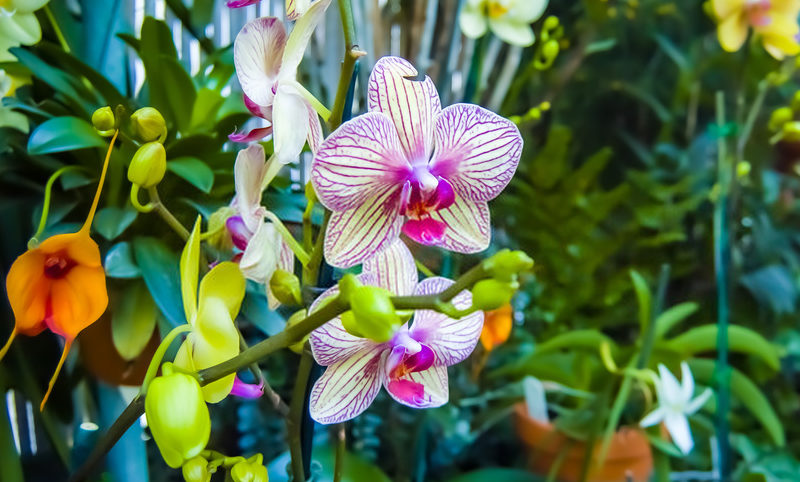The world of orchids is vast and populated with well-known tropical varieties but also with species much better adapted to life outdoors. Hardy, vigorous and resistant, they will find their place in our gardens!
Many species share this privilege, ensuring staggered flowering from April to October if you make room for them in your garden.
Generally low maintenance, they require little care and over time form large clumps that decorate beds, undergrowth, rock gardens or borders of paths with charm. Beware, once convinced, you are likely to collect them!
Contents
Can I leave my orchid outside?
Indoor orchids are very beautiful flowers that are nevertheless fragile and require special care. So, can I still take them outside in summer? In fact, it all depends on the variety. Some will appreciate more light than indoors. This is the case for Brassidium or Pholidota orchids.
On the other hand, for the Phalaenopsis, you have to be careful: this kind of orchid does not like to be exposed to direct sunlight and does not tolerate draughts. If you really want to give it some fresh air, it is best to protect it under an arbour or along a wall. You should also make sure that the temperature changes between day and night are not too drastic.
Which orchids can be taken out to the garden?
Fortunately, some orchids are more robust than others. Don’t forget that some orchids can be planted outside in the garden! Here is a list of 6 orchids that can be left outside:
1. Cypripedium, the Venus hoof
Better known as “Venus’ hoof”, these orchids are without a doubt the most resistant to the cold, especially if you look at the hybrids obtained recently in order to withstand temperatures below -4°F as well as relative heat (no more than 86°F all the same!). The cultivar ‘Gisela’ can cheerfully withstand up to -31°F without suffering!
These orchids, native to Canada, Northern Europe or the United States, appreciate half-shade and a cool soil, sometimes acidic for Cypripedium reginae, sometimes calcareous for Cypripedium calceolus. A northern exposure will suit them perfectly, especially in warm regions.
2. Dactylorhiza
The genus Dactylorhiza includes about thirty species of tuberous terrestrial orchids growing spontaneously in marshy areas or meadows of Asia, Northern Europe and Africa. These plants bloom from May to September depending on the species, in erect clusters with tightly packed flowers with protruding bracts. The flowers are white, purple, lilac, fuchsia, sometimes even spotted.
Dactylorhizas like part shade and rich, cool soil. From 6 to 30 inches high depending on the variety, these orchids can be used as borders of alleys or beds, as well as in the center of a bed, or even in a wet rock garden.
3. Epipactis
Epipactis are terrestrial orchids that are very easy to grow. The genus includes 24 species and many cultivars. These rhizomatous plants grow naturally in meadows, marshy areas and undergrowth in temperate zones of the Northern Hemisphere. Epipactis gigantea can grow up to 20 inches tall and can withstand temperatures down to -13°F.
A single plant can have a spread of 6 ft over time! Epipactis thrives in moist, drained, humus-rich soil in shade or part shade in cooler regions. The long-lasting flowering with flowers grouped in spikes lasts from early spring until July. Special mention for the very original Epipactis veratrifolia with green flowers edged with brown and for Epipactis palustris, one of the rare species that can be grown on the edge of a pond.
4. Gymnadenia
The genus includes the species Gymnadenia conopsea and Gymnadenia odoratissima, native to northern Europe and the Ural steppes. These terrestrial orchids appreciate sun or even half-shade and are perfect in rock gardens or in beds.
In addition to the beauty of the crimson flowers borne in erect spikes in June-July, it is above all the intoxicating perfume that emanates from them that the gardener will remember. With its vanilla scent, it attracts all the pollinating insects!
5. Orchis
This genus is very interesting because it includes nearly 35 species of very hardy orchids that grow in poor, rocky, dry soil and if possible in slightly subdued sunlight. These plants are therefore very well suited to rock gardens or to decorate a natural meadow or even a slope.
The flowers carried in compact and upright clusters, present a spur. The colors vary from white to green passing by all the nuances of purple or red. Sometimes spotted or spotted they bloom quite early in spring.
6. Spiranthes
Spiranthes are beautiful orchids to be reserved for the mildest regions because they tolerate short episodes of cold, but not heavy frosts.
These orchids appreciate a light, well-drained, acid and fertile soil. They like semi-shade where they can grow at leisure if the location is sheltered from the prevailing winds. The white flowers are borne in very original spiral spikes of 28 inches high. Spiranthes ‘Chadd’s Ford’ takes over the flowering in October. Its spike then embalms the area with sweet fragrances.
Where to place an indoor orchid outdoors during the summer?
An orchid’s need for sunlight is not the same in summer as in winter.
Paradoxically, it is in summer that it should be protected from the sun’s rays.
The orchid tolerates the morning sun well, but not the afternoon sun.
Protect the orchid from the sun as soon as it starts to beat down, around 12 o’clock, by placing it in the shade.
The ideal is to find a place where it has sun until noon and shade in the afternoon (with a good light anyway)
For the varieties that tolerate the sun even in summer, prefer the cymbidium orchid for example.









